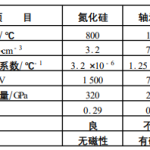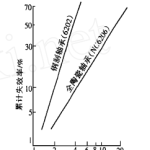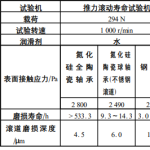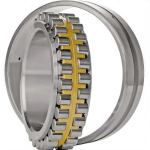Time : July 18, 2023
There are various types of ceramic materials, and only silicon nitride (Si3N4) can be competent as a ceramic material for rolling bearings in terms of rolling fatigue life and reliability. Silicon nitride has excellent properties such as lightweight, insulation, insulation, non magnetic, high temperature resistance, corrosion resistance, wear resistance, low centrifugal force during high-speed rotation, and low operating temperature rise. Ceramic bearings that utilize these properties have been applied to machine tool equipment such as aerospace, military, petroleum, and high-speed electric spindles, corrosion resistance, and are gradually developing new application fields to fully utilize the performance of ceramic materials.
1.Performance of ceramic bearings
1.1 Physical and mechanical properties of silicon nitride materials
Table 1 shows the comparison of physical properties between silicon nitride and bearing steel. Silicon nitride has a high elastic modulus, so its contact stress is higher than that of steel bearings under the same load.
Table 1 Comparison of Physical Properties between Silicon Nitride and Bearing Steel

1.2 Rated static load
The rated static load of all ceramic bearings should be studied for the allowable load when silicon nitride cracks occur. The calculation method for the rated static load is the same as that of steel bearings. Regarding hybrid ceramic bearings, research should be conducted on the permanent deformation of the ring, with a rated static load of approximately 85% of that of steel bearings. Some literature suggests using Hertz induced cracking load to evaluate the rated static load of ceramic bearings. When bearing steel balls or silicon nitride balls are loaded onto silicon nitride plates, the cracking load is 10 times the rated static load obtained by traditional calculation methods for steel bearings.
1.3 Rolling fatigue life
Based on the rated dynamic load, operating load, and rotational speed of ceramics, the lifespan of bearings can be calculated using a life calculation formula. Figure 1 shows the comparison test results of the lifespan of ceramic bearings and steel bearings. The test conditions are: axial load 5 800 N, rotational speed 8 000 r Π Min, temperature 70 ± 2 ℃, lubricant is aviation turbine oil 500.
Figure 1 Rolling Fatigue Life Test Results

The experimental results show that the working life of ceramic bearings is longer than the expected life and that of steel bearings of the same type. The rated dynamic load of steel bearings can be used for ceramic bearings of the same size.
1.4 Crushing load
The crushing load of silicon nitride balls is 30% of the crushing load of steel balls of the same specification 5% to 47% is caused by the increase in contact surface caused by plastic deformation of the steel ball. The contact stress level between ceramic balls and steel balls during crushing is equivalent. Under the same contact state between silicon nitride balls and steel balls, ceramic balls have a higher crushing load than steel balls. The crushing contact stress of silicon nitride balls is about 6 times the rated calculated contact stress of rolling bearings, and silicon nitride balls can be safely used in rolling bearings.
1.5 Coordination
Due to the different linear expansion coefficients of silicon nitride and metal materials used in ceramic bearings, there are certain problems in the coordination between all ceramic bearings and metal shafts. All ceramic bearings are often used in high-temperature environments. In order to solve compatibility problems, hollow shafts and spline shafts are commonly used in experiments.
1.6 High speed rotation performance
Ceramic bearings can exhibit excellent high-speed rotational performance due to their low density of silicon nitride, which reduces sliding caused by centrifugal force and rotational torque, resulting in a 20% to 40% increase in rotational speed compared to steel bearings. In high-speed rotation, most of the power consumption of bearings is brought about by the stirring resistance of lubricating oil, while ceramic bearings are less prone to melting compared to steel bearings, thus reducing the amount of lubricating oil and reducing bearing power consumption. The friction coefficient of ceramics is approximately 30% of that of steel, so ceramic bearings generate less heat, have low temperature rise, and can extend the lifespan of lubricating oil.
2.Performance of all ceramic bearings in special environments
2.1 Performance in High Temperature Environments
Silicon nitride has good heat resistance and is expected to become a bearing material in high-temperature environments. Lubricating oil or grease cannot be used for bearings working in high temperature environment, while silicon nitride material itself has self-lubricating performance, which is used together with solid lubricant graphite, Molybdenum disulfide, etc. High temperature bearing self-lubricating cage is selected, which can work normally in high temperature environment.
2.2 Performance in corrosive environments
The inactive chemical properties of ceramic materials give ceramic bearings good corrosion resistance. Self lubricating and corrosion-resistant cage materials can be used in conjunction with them, thus being applied in water or corrosive pharmaceutical environments. When used in medicinal liquids, due to the special nature of ceramic materials, the medicinal liquid itself can be used as a lubricant, but attention should be paid to mastering the bearing capacity and service life of ceramic bearings in the medicinal liquid. Table 2 compares the life test results of ceramic bearings and stainless steel bearings in water. It can be seen that the wear resistance life of all ceramic bearings used in water is more than 10 times that of stainless steel bearings.
Table 2 Life test results of ceramic bearings and stainless steel bearings in water

2.3 Performance in magnetic field environments
In a magnetic field, the torque of steel bearings increases and changes significantly, while the torque of ceramic bearings remains almost unchanged and does not disturb the magnetic field. It can be used in semiconductor manufacturing devices and various detection instruments.
2.4 Performance in Vacuum Environment
Ceramic bearings can also perform well in vacuum environments because silicon nitride materials are difficult to react with other substances, and even under harsh lubrication conditions, they are not prone to adhesion or melting. The ceramic bearing with solid lubricant has small Friction torque and long service life in vacuum environment. There are also literature indicating that hybrid ceramic bearings have a lower dust emission than steel bearings.
3.Application of ceramic bearings
In the past, hybrid ceramic bearings were mainly used in precision machine tool spindles due to their excellent performance, thereby improving the speed and rigidity of machine tools. If the performance of ceramic bearings can be fully utilized, not only can they meet the high-speed requirements, but also extend their lifespan and simplify the pre tightening and lubrication devices. In recent years, ceramic bearings have been applied in many fields due to cost reduction.
(1) Automobile
Among the bearings used in automobiles, the turbine charger bearing has the highest speed requirement, which requires good acceleration reactivity, as well as low torque, low vibration, and low temperature rise under high-speed rotation. Due to the low temperature rise during operation of ceramic bearings, the amount of lubricating oil can be reduced, resulting in a decrease in oil stirring resistance, a decrease in bearing torque, and an increase in rotational speed. In addition, railway vehicles also use ceramic bearings, whose durability and reliability under harsh conditions have been confirmed.
(2) Electric motor
When the motor is used for deceleration and energy-saving devices, the leakage in the motor can cause arc discharge, and the ceramic bearing can achieve permanent insulation.
(4) Aircraft parts
The aircraft manufacturing industry has used ball screws equipped with ceramic balls for aircraft flap adjusters, and has also attempted to use hybrid ceramic bearings in the engines of gas turbines. However, due to the inability to detect internal defects in the ceramic balls to ensure that they do not fail, the progress of this research is very cautious, and multi-level and extensive reliability tests must be conducted to verify their lifespan.
(5) Medical surgical instruments
Ceramic bearings have been used in high-speed dental drills and surgical saws, which are durable and can withstand disinfection.
(6) Food processing equipment and chemical instruments
Corrosion resistance is a key factor in the application of bearings in such equipment, and grease lubrication cannot be used, while ceramic bearings have low lubrication requirements and are fully applicable.
(7) Superconducting device
Due to its non magnetic nature, ceramic bearings can be used in superconducting devices and semiconductor manufacturing equipment.
4.Development Trends of Ceramic Bearings
The excellent performance of ceramic bearings is obvious, but the time for ceramic materials to be used in bearings is relatively short and is still in the research and development stage. Some technical difficulties related to ceramic bearings, such as poor toughness, high processing costs, and unreliable quality assurance measures, have not been well resolved. To address these issues, efforts should be made in the following areas of research.
More about XZBRG Cylindrical roller bearings:
Cylindrical roller bearings are also available in sealed or split designs. In sealed bearings, the rollers are protected from contaminants, water and dust, while providing lubricant retention and contaminant exclusion. This provides lower friction and longer service life. Split bearings are intended primarily for bearing arrangements which are difficult to access, such as crank shafts, where they simplify maintenance and replacements.
